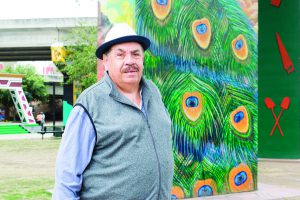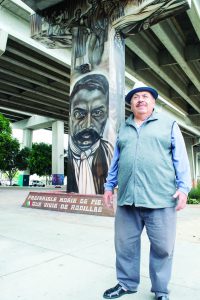Victor Ochoa: Painting Our History

His powerful murals can be seen all over California, and even in other countries. But most San Diegans see them everyday when they drive through Barrio Logan, or pose for pictures in front of them at Chicano Park.
To say that Victor Ochoa has left his mark on the community would be an understatement. He is an educator, artist, mentor, father, activist, and leader. Ochoa is a founding member of the Centro Cultural de La Raza, co-founder of Chicano Park, a member of the Border Art Workshop, and much more.
Ochoa was born in East Los Angeles to two undocumented parents who moved to the United States during World War II to work on trains and make uniforms. His parents were deported after the war in 1955 to Tijuana along with Ochoa and his younger sister.
Ochoa lived in Tijuana for ten years and he learned how to speak Spanish, about Mexican history, and how to be proud of being Mexican, he said.
Ochoa said he is actually thankful that immigration booted him and his family out because he was given the opportunity to be completely binational and become educated in Mexican heritage.
Eventually, he returned to the U.S. on his own to continue his education in East Los Angeles and although he experienced some roadblocks, his love for education and art encouraged him to go on.
“The art part was an added thing to what I loved about school and that to me personally was my main motivation as far as wanting to continue my education no matter what,” Ochoa said. “When you’re poor your education is tied to what kind of job you’re going to get.”
Ochoa depended on living on the kindness of friends and family, but he worked hard doing little jobs like mowing lawns and washing cars to support himself because his parents did not earn enough money in Mexico to help him.
At the age of 16, Ochoa had a job, his own apartment, attend a continuation school and had his sister living with him while she was in high school.
He went to City College and received a Bachelor’s degree from San Diego State University in fine arts with an emphasis in education.

His reason for selecting education as an emphasis was related to his work on the murals in Chicano Park. He said that around 300 people showed up to put in their ideas for what should go on the mural and it was like teaching a class.
“It’s not just a Victor Ochoa mural, it’s really a community mural. Everybody has input like what’s the issue that you would like to see?” he said.
Ochoa discovered his “Chicano attitude” when he returned to East Los Angeles after a teacher told him and a couple of Spanish speaking students he was touring around the school, to not speak Spanish at the school.
Despite not being a violent person, Ochoa said he punched the teacher because he was “repugnado”, or so disgusted by what the teacher had said to them.
Ochoa said his murals serve to address certain issues in the community.
There have been countless stories and pictures on Chicano culture and Chicano communities but Ochoa said they often fail to really understand the people.
“I always have to tell people, what percentage do you think of our population is low riders? Is a cholo? You’re coming over here to project something back about our community and it is part of our phenomenon, but it’s not the whole thing. If you don’t treat it properly it’s misunderstood,” Ochoa said.
Ochoa has been teaching for over 47 years but despite his strong belief in education, he believes that if education is not respecting the culture and history of the people then it should be questioned.
Ochoa recalls that one of his two children asked him to not speak Spanish in public and he wondered what made his son think this way.
He said that the belief that embracing one’s culture, heritage and learning the history is going backwards is not right.
Ochoa said the best way to learn about your history is to travel to the country and spend time with the people because it is a learning experience.





